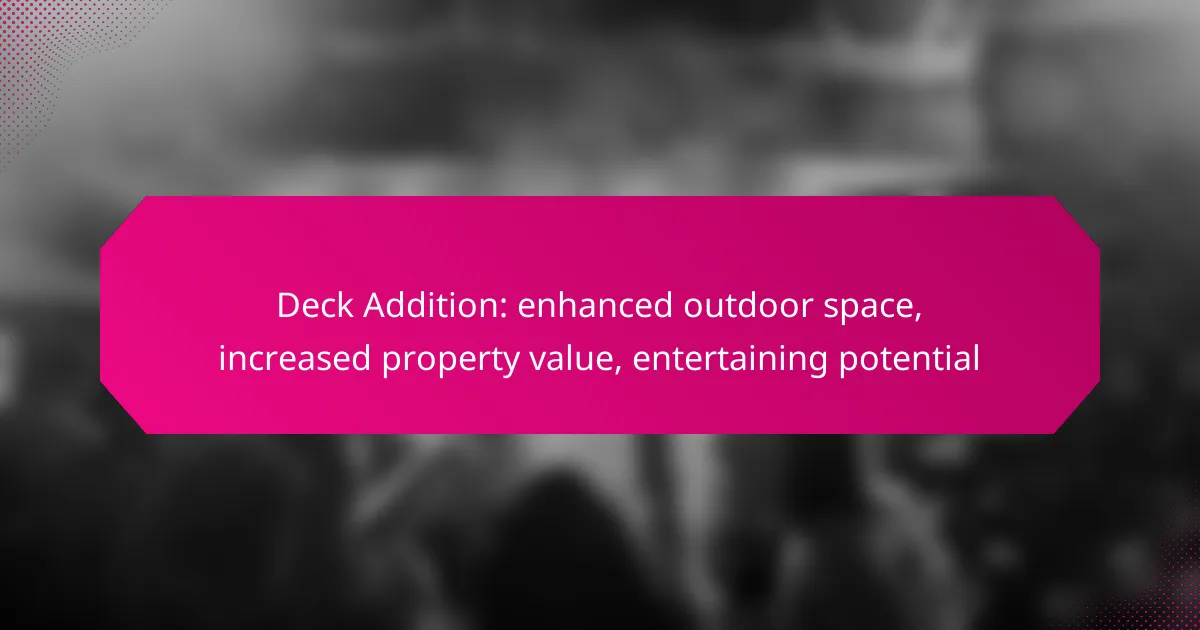A deck addition is an excellent way to enhance your outdoor space, offering a functional area for relaxation and entertainment. This upgrade not only boosts the aesthetic appeal of your home but also increases its property value, making it an attractive feature for potential buyers. With a deck, you can create an inviting atmosphere for social gatherings, allowing friends and family to enjoy the outdoors together.

How can a deck addition enhance outdoor space in the UK?
A deck addition can significantly enhance outdoor space in the UK by providing a functional area for relaxation and entertainment. It creates a seamless transition between indoor and outdoor living, making it an attractive feature for homeowners and potential buyers alike.
Increased usable area
A deck expands the usable area of your property, allowing for more outdoor activities such as dining, lounging, or hosting gatherings. This additional space can be particularly beneficial in smaller gardens where every square meter counts.
When planning a deck, consider its size and layout to maximize functionality. A well-designed deck can accommodate furniture and amenities, effectively transforming your outdoor space into a versatile extension of your home.
Improved aesthetics
Adding a deck can enhance the visual appeal of your property, contributing to a more inviting atmosphere. A well-constructed deck can complement the architectural style of your home and improve overall curb appeal.
Choosing materials that blend with your existing landscape, such as natural wood or composite decking, can further enhance aesthetics. Consider adding decorative elements like railings, lighting, or planters to create a cohesive look.
Integration with landscaping
A deck can be seamlessly integrated with your existing landscaping, creating a harmonious outdoor environment. This integration allows for better flow between different areas of your garden, enhancing the overall experience.
When designing your deck, think about how it interacts with plants, pathways, and other features. For instance, positioning the deck near flower beds or trees can provide shade and beauty, while strategically placed steps can lead to different garden zones.

What is the impact of a deck addition on property value?
A deck addition can significantly enhance property value by creating appealing outdoor spaces that attract potential buyers. This improvement not only increases the overall aesthetic of the home but also adds functional space for entertaining and relaxation.
Higher resale value
Adding a deck typically boosts the resale value of a property, often recouping a substantial portion of the investment. Homeowners can expect to see returns ranging from 60% to 80% of the cost, depending on the materials used and the local real estate market conditions.
For example, a well-constructed wooden deck in a suburban area may add thousands of dollars to the home’s value, making it a worthwhile investment for many homeowners looking to sell.
Market appeal
A deck enhances market appeal by providing an attractive outdoor space that buyers desire. Many prospective homeowners prioritize outdoor living areas, especially in regions with favorable climates, making a deck a strong selling point.
Properties with decks often stand out in listings, potentially leading to quicker sales and competitive offers. Features like built-in seating or lighting can further elevate a deck’s attractiveness.
Investment return
The return on investment (ROI) for a deck addition can vary based on factors such as location, design, and materials. Generally, homeowners can expect a solid ROI, especially if the deck complements the home’s style and the surrounding landscape.
To maximize investment returns, consider using durable materials that require less maintenance and appeal to a broad range of buyers. Consulting with local real estate agents can provide insights into the most desirable features in your area.

How does a deck addition improve entertaining potential?
A deck addition significantly enhances entertaining potential by providing an inviting outdoor space for social gatherings. It creates an area where friends and family can enjoy meals, relax, and engage in activities, all while enjoying the fresh air and natural surroundings.
More space for gatherings
Adding a deck increases the usable square footage of your home, allowing for larger gatherings without feeling cramped. This extra space can accommodate outdoor furniture, dining sets, and recreational areas, making it ideal for parties, barbecues, or family reunions.
Consider the layout and size of your deck. A deck that is at least 200 square feet can comfortably host a small group, while larger decks can cater to bigger events. Ensure there’s enough room for movement and seating to maximize comfort.
Versatile design options
Decks offer a variety of design options that can be tailored to suit different entertaining styles. You can choose from various materials, shapes, and layouts, allowing you to create a space that reflects your personal taste and complements your home.
For instance, a multi-level deck can provide distinct areas for dining, lounging, and cooking, while built-in seating and planters can enhance the aesthetic and functionality. Consider features like railings, lighting, and shade structures to further customize your deck.
Enhanced outdoor cooking areas
Incorporating an outdoor kitchen or grilling station on your deck can elevate your entertaining experience. This setup allows for cooking and serving meals outdoors, which is particularly enjoyable during warm months.
When planning your outdoor cooking area, consider including a grill, sink, and countertop space for food preparation. Ensure that utilities such as gas and water are accessible, and check local regulations regarding outdoor cooking installations to ensure compliance.

What are the costs associated with deck additions in the UK?
The costs of deck additions in the UK can vary widely based on materials, labour, and ongoing maintenance. Homeowners should budget for both initial construction expenses and future upkeep to ensure a successful investment in their outdoor space.
Material costs
Material costs for deck additions can range from a few hundred to several thousand pounds, depending on the type of materials chosen. Common options include pressure-treated wood, composite materials, and hardwoods, each with different price points and durability. For example, pressure-treated wood may cost around £100-£200 per square metre, while composite materials can range from £150-£300 per square metre.
When selecting materials, consider not just the upfront costs but also the long-term value and maintenance requirements. Higher-quality materials may have a higher initial cost but can offer better longevity and lower maintenance needs.
Labour expenses
Labour expenses for deck construction typically account for a significant portion of the total cost. In the UK, skilled labour rates can range from £150 to £250 per day, depending on the contractor’s experience and location. The complexity of the deck design and the time required for installation will also influence labour costs.
To manage labour expenses effectively, obtain multiple quotes from contractors and check their references. Clear communication about your design preferences and budget can help ensure that you receive accurate estimates and avoid unexpected costs.
Maintenance considerations
Maintenance is an essential aspect of owning a deck, impacting both its longevity and overall costs. Regular upkeep may include cleaning, sealing, and repairing any damage, which can add up over time. For example, homeowners should plan to spend around £100-£300 annually on maintenance, depending on the materials used and the local climate.
To minimize maintenance costs, choose materials that require less frequent upkeep and consider applying protective coatings. Additionally, regular inspections can help identify issues early, preventing more extensive repairs and costs down the line.

What materials are best for deck additions?
The best materials for deck additions include wood, composite materials, and metal decking, each offering unique benefits and considerations. Choosing the right material depends on factors like budget, maintenance, and desired aesthetics.
Wood options
Wood is a classic choice for deck additions, providing natural beauty and warmth. Common types include pressure-treated pine, cedar, and redwood, each varying in durability and cost, typically ranging from moderate to high prices per square foot.
When selecting wood, consider its resistance to rot and insects. Pressure-treated wood is often the most affordable but may require regular sealing and maintenance to prolong its lifespan.
Composite materials
Composite materials are made from a blend of wood fibers and plastic, offering a low-maintenance alternative to traditional wood. They are resistant to fading, staining, and insects, making them a popular choice for homeowners looking for durability.
While composite decking can be more expensive upfront, its longevity and minimal upkeep can lead to cost savings over time. Look for brands that offer warranties of 20 years or more to ensure quality.
Metal decking
Metal decking, often made from aluminum or steel, is known for its strength and resistance to weather conditions. This option is less common but can be ideal for modern designs and commercial applications.
Metal decks typically require less maintenance and are fire-resistant, but they can be more expensive than wood or composite options. Consider insulation and surface treatments to enhance comfort and aesthetics, as metal can become hot in direct sunlight.

What design styles are popular for deck additions?
Popular design styles for deck additions include traditional wooden decks, modern minimalist designs, and multi-level decks. Each style offers distinct aesthetics and functionality, catering to various preferences and outdoor space requirements.
Traditional wooden decks
Traditional wooden decks are a classic choice, often made from materials like cedar or redwood. These decks provide a warm, natural look that complements many home styles and landscapes.
When considering a traditional wooden deck, think about maintenance requirements, as wood needs regular sealing and staining to prevent weather damage. Additionally, ensure that the wood is sourced sustainably to support environmental practices.
Modern minimalist designs
Modern minimalist designs focus on clean lines and open spaces, often using materials like composite decking or aluminum. This style emphasizes simplicity and functionality, making it ideal for contemporary homes.
To achieve a minimalist look, consider features such as built-in seating, integrated lighting, and a neutral color palette. These elements enhance the aesthetic while maximizing usability without clutter.
Multi-level decks
Multi-level decks are designed to create distinct areas for various activities, such as dining, lounging, and gardening. This style is particularly useful for sloped yards, allowing for better use of space.
When planning a multi-level deck, consider the layout carefully to ensure smooth transitions between levels. Adding railings and steps can enhance safety and accessibility, making it a practical choice for families and entertaining guests.
